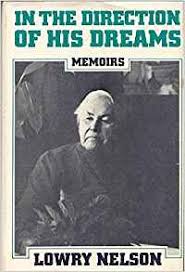Articles/Essays – Volume 20, No. 3
Lowry Nelson’s Utah | Lowry Nelson, In the Direction of His Dreams, Memoirs
Lowry Nelson was one of Utah’s greatest intellectual products. At age ninety-three, this, the final volume of an autobiographical trilogy rounds off Boyhood in a Mormon Village and Eighty: One Man’s Way There. Nelson’s new volume completes a study that transcends one man’s life. The internationally renowned rural sociologist vividly recalls his childhood in Ferron, Utah, and traces the path that led him to prominence.
With amazing candor, clarity, humility, and grace, Nelson condenses nine decades into an inspiring and uplifting chronicle. He cleverly combines family history and a sense of community to describe life as a pioneer in Emery County at the turn of the century. His education was characterized by a near-obsession to learn and see
and experience. His descriptions of both Brigham Young University and Utah State in their youth are poignant and refreshing. The vivid recollections of travelling by train within Utah and by car to California and Wisconsin long before pavement are insightful and amusing.
However, the indisputable charm of this book is the manner in which Lowry Nelson underplays his own importance and significance. As a pioneer in agricultural extension work, a New Deal administrator, a member of the International Labor Organization, and a scholar, Nelson never indulges in self-adulation. He writes about those upset by his studies of rural Utah, barely mentioning the rave scholarly re views. He assumes that the reader is aware of the impact of his A Mormon Village, so he hardly mentions it.
In two instances, Nelson reveals details of his well-known disagreements with the LDS hierarchy. As a professor at BYU, he was the focal point of a serious academic freedom issue. Upon losing the battle and after numerous meetings with Church leaders, he concluded that academic freedom was not possible at BYU. That is one rea son he joined the New Deal’s Resettlement Administration. Years later, he confronted Church leaders over the denial of priest hood to blacks. His exchange of letters, included here, provide interesting documentation of racial perceptions of the 1940s.
It was remarkable that Lowry Nelson was still producing prose and poetry up to last year. It is also important to realize that he has much to say about how human beings should work together for survival. His editor should have caught some trivial mistakes such as having the Wilson-Roosevelt-Taft election in 1908 instead of 1912, and locating Johnston’s Army still in Sanpete County in 1867. They are minor problems in a memoir of such significance.
In the Direction of His Dreams, Memoirs by Lowry Nelson (New York: Philosophical Library, Inc. 1986), 370 pp., $19.95.


 Back to full Issue
Back to full Issue

